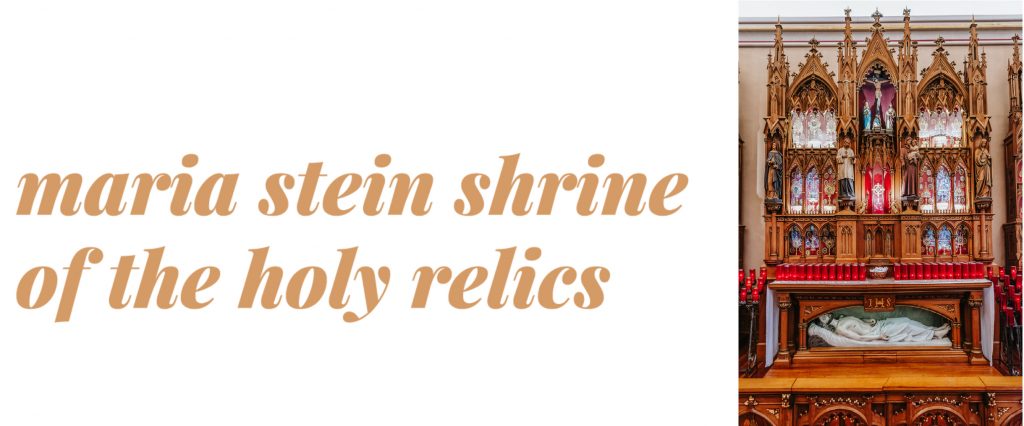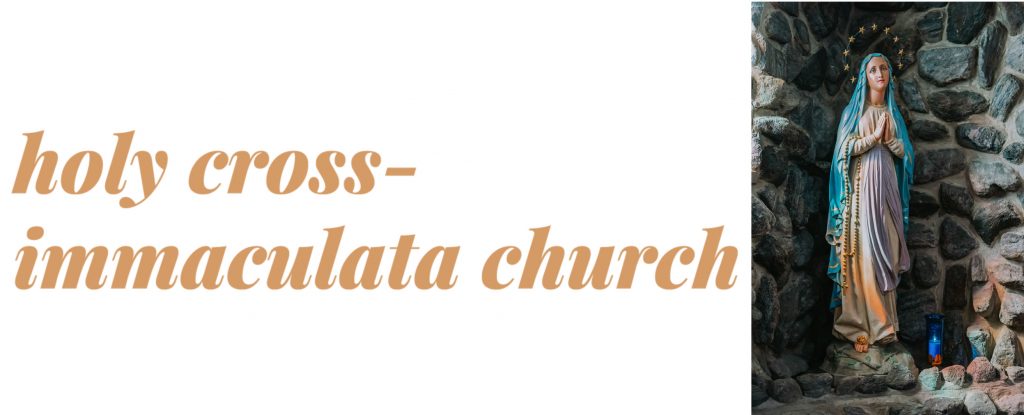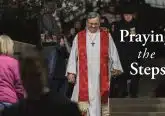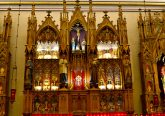Major Shrines in the Archdiocese of Cincinnati
by Gail Finke
What is a shrine? Associated with popular piety since the earliest days of the Church, shrines are places of pilgrimage and prayer. Pope St. John Paul II once said, “Christian shrines have always been, and continue to be, signs of God, and of His intervention in history. Each one of them is a memorial to the Incarnation and to the Redemption.”
According to Archdiocese of Cincinnati Chancellor Father Steve Angi, Canon Law stipulates local shrines be approved by local bishops, national shrines approved by a country’s council of bishops and international shrines approved by the pope.
According to the official Directory on Popular Piety and the Liturgy, many places “often humble little churches in the cities or in the countryside, locally fulfill the same functions as shrines, even without canonical recognition. These also form part of the ‘topography’ of the faith… of a particular community living in a specific geographical area, on its journey towards the heavenly Jerusalem in faith.”
The Archdiocese of Cincinnati is home to one national shrine, two local shrines, and many popular places for special prayers or devotions.

Home of the second-largest collection of relics in the U.S. and located in the scenic “Land of the Cross-Tipped Churches,” the Maria Stein Shrine of the Holy Relics is part of a complex of buildings that date back to the 1840s. The site was once a center of Catholic missionary activity, the Motherhouse of the Sisters of the Precious Blood and a pilgrimage destination for Catholics from around the country.
The first Sisters of the Precious Blood in the archdiocese lived on the same property as Precious Blood fathers and brothers, who later moved to Dayton. Father Brunner, who brought the sisters over with him from Europe, also brought more than 1,000 relics to Maria Stein in 1875. The relics drew so many visitors that a separate staircase was required to keep them from the sisters. In the late 1880s, the convent became the Motherhouse of all Precious Blood sisters, and a new, larger, building was built to serve that purpose until 1923, when the motherhouse moved to Dayton. In the 1950s, a lay Adoration Guild took over Eucharistic Adoration, which the sisters had practiced at Maria Stein since their pioneer days. The convent eventually became a retreat center.
Now the Spiritual Center of Maria Stein is run by a lay board, as is the separate Shrine of the Holy Relics. The Shrine Chapel holds more than 1,200 relics, and the Heritage Museum tells the story of missionary work in early Auglaize and Mercer counties. Adoration continues in the adoration chapel, a gift shop supports the property, and a variety of special Masses, prayer services and programs are held throughout the year.
TAKE A TRIP
2291 St. Johns Road, Maria Stein, OH 45860
CALL (419) 925-4532
EXPLORE ONLINE MariaSteinShrine.org
One of the most popular saints in the world, St. Anthony of Padua was an Augustinian priest who joined the Franciscans after seeing the bodies of martyred missionary Franciscans processed to his monastery. He hoped to become a missionary to Morocco, but was shipwrecked in Sicily, where his gift for preaching sent him all over Italy. His commitment to poverty and humility earned him universal respect. Shortly before he died at age 36, he delivered a series of talks so popular that he needed bodyguards to protect him from people trying to cut his robes apart for relics.
The National Shrine of St. Anthony is located on spacious grounds atop a hill in Cincinnati’s Mt. Airy neighborhood, along with a friary and an outdoor shrine to St. Anthony, St. Francis and Our Lady of Guadalupe. Built in the late 1880s, the church that now houses the shrine originally had eight side chapels and elaborate, Tyrolian-style paintings. It was renovated in 1978. The church and shrine are open year-round for prayer, and every Tuesday they host a novena service in the afternoon and novena Mass in the evening. Both end with Eucharistic exposition and a blessing with a first-class relic of St. Anthony. The novena is especially attended during the nine weeks leading up to the saint’s feast day on June 13, when celebrations include the distribution of blessed “St. Anthony Bread” to take home and eat.
In the church, a shrine to the saint opposite the altar includes a computer screen that displays prayer intentions sent in from around the world, so that the friars and visitors can pray together for each other.
TAKE A TRIP
5000 Colerain Avenue, Cincinnati, OH 45223
CALL (513) 721-4700
EXPLORE ONLINE: stanthony.org
Dedicated in 1964, the Our Lady of Fatima Shine at Indian Lake was the tallest statue of the Virgin Mary in the world at the time. It was located in a Catholic park run by George B. Quatman on the grounds of the former Sandy Beach Amusement Park, “The Atlantic City of the West.” Quatman’s San Juan Amusement Park featured wholesome entertainment and a train ride past the statue, which rotated to recorded music, surrounded by dancing waters and lit with colored lights and a life-sized statue of the Last Supper. All profits went to charities.
Only Our Lady of Fatima remains. The fiberglass statue stands at 19’ 6”, part of a 43-foot monument built and supported by the American Society of Ephesus (ASE). Quatman founded ASE in the 1950s to support holy sites in Turkey, including the home of the Virgin Mary in Ephesus, and to build shrines in Turkey and the U.S. The Indian Lake shrine celebrated its 50th anniversary in 2014, when ASE restored the wooden Stations of the Cross signs set up around “St. Mary’s Point.” In 2017, ASE added a lacy white metal fence and gate designed to resemble a lace veil, honoring the centennial of the apparitions of Mary in Fatima.
Today St. Mary of the Wood parish in Russells Point holds a Monday evening Rosary at the statue from May to October, and a Eucharistic procession to the statue followed by a “family fun day” in September. Every August, an outdoor Mass on the Feast of the Assumption draws large crowds. The shrine is open daily for devotion and prayer.
TAKE A TRIP
261 Chase Avenue, Russells Point, OH 43348
EXPLORE ONLINE SaintMaryoftheWoods.com/Fatima ASE-GBQfoundation.org
Built by Archbishop John Baptist Purcell, the church now known as Holy Cross-Immaculata is home to the unique tradition of “praying” or “making the steps” on Good Friday. Praying to the Virgin Mary during a storm at sea, Archbishop Purcell promised that if he lived, he would build a church dedicated to her on the city’s highest point. That cornerstone was laid in 1859.
According to the parish’s official history, Archbishop Purcell asked people from all over the city to contribute to building the church, and to climb the steep hillside while praying for the needed funds. According to an article by the Passionists, who staffed the church for decades, the origin of the practice may be have been similar Bavarian traditions loved by German parishioners. Either way, the faithful have gathered from all over the region to pray on the hill beginning at midnight on Good Friday, and on the various sets of steps built since then.
“Immaculata,” as Archbishop Purcell called the church, holds several holy relics and is home to other annual devotional practices. Though it’s not official, the church is a de facto shrine, according to the pastor, Father Len Fecko. “Archbishop Purcell wanted it to be a shrine to honor Mary,” he said. “We’ll go with Archbishop Purcell.”
TAKE A TRIP
30 Guido St., Cincinnati, OH 45202
EXPLORE ONLINE HCIParish.org
Want more? Ohio is home to shrines large and small, including:
• National Shrine of Our Lady of Lourdes, Euclid
• Sorrowful Mother Shrine, Bellevue
• Basilica and Shrine of Our Lady of Consolation, Carey
• Jubilee Museum and Catholic Cultural Center, Columbus
• National Shrine of Our Lady of Lebanon, North Jackson
• Servants of Mary Center for Peace/Shrine of Our Lady of Guadalupe, Windsor
• National Shrine of St. Dymphna, Massilon
• Shrine of Our Lady of Mariapoch, Burton
• Shrine of the Conversion of St. Paul, Cleveland
This article appeared in the June 2021 Bicentennial Edition of The Catholic Telegraph Magazine. For your complimentary subscription, click here.

















